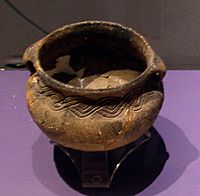Bentley site facts for kids
| Location | South Portsmouth, Kentucky, Greenup County, Kentucky, |
|---|---|
| Region | Greenup County, Kentucky |
| Coordinates | 38°43′17.76″N 83°1′22.98″W / 38.7216000°N 83.0230500°W |
| History | |
| Founded | Ca. 1400 |
| Abandoned | 1625 |
| Periods | Madisonville horizon, protohistoric |
| Cultures | Fort Ancient culture |
| Architecture | |
| Architectural details | Number of monuments: |
|
Bentley site
|
|
| NRHP reference No. | 83002784 |
| Added to NRHP | April 28, 1983 |
The Bentley site (also called 15Gp15) is an important archaeological site in Kentucky. It was once a village where people from the Fort Ancient culture lived a very long time ago, starting around the year 1400. Later, in the 1700s, a Shawnee village was built on top of the older site.
The Bentley site is located near South Portsmouth, Kentucky, in Greenup County, Kentucky. It is part of a larger area called the Lower Shawneetown Archeological District. This site was added to the National Register of Historic Places in 1983 because of its historical importance. It is also close to some much older mounds built by the Hopewell tradition people between 100 BCE and 500 CE.
What Was the Bentley Site Like?
The Bentley site was a village about the size of three football fields. It was built on a slightly raised area next to the Ohio River, right across from where the Scioto River flows into it.
Archaeologists, who are like history detectives, dug up parts of the site in the 1930s. They found that the buildings and how they were made were similar to those at another Fort Ancient village called the Hardin Village site, which is about 13 kilometers (8 miles) away.
People lived at the Bentley site for a long time, from about 1400 to 1625 CE. The village probably had between 250 and 500 people. They lived in long, rectangular houses that were covered with bark. These houses likely had several fireplaces and inner walls, suggesting that multiple families shared one home.
Tools and Treasures Found Here
Before Europeans arrived in this area, the people at Bentley traded with other villages. We know this because archaeologists found special items in graves. These included beautiful shell gorgets, which are like necklaces or decorations made from seashells. These shells came from far away, like the coasts of Florida and the Gulf of Mexico! The Fort Ancient people probably traded salt for these shells. They got salt by boiling salty water (called brine) until only the salt was left.
Archaeologists also found many other interesting things during their digs:
- Pottery: They found unique clay pots, some with rope marks on them, others plain or with special patterns.
- Stone Tools: There were many tools made from chert, a type of stone. These included sharp points for arrows or spears, scrapers for preparing animal hides, and ceremonial pipes.
- Bone Tools: People also made tools from bone, such as awls (for poking holes), chisels, fishhooks, and pins.
- Decorations: They found decorative items like pendants, earplugs, and beads made from freshwater mussel shells.
- Pipes: Tobacco pipes made of stone and ceramic were also discovered.
A few items from Europe were found, like beads, bracelets, and tubes made of copper or brass. It's likely that the people at Bentley didn't get these directly from Europeans. Instead, they probably got them through trade with other Native American groups who had met Europeans.
Over 300 burials were found at the site. Some of the skeletons showed signs of diseases like tuberculosis and yaws, which are infections.
Why the Village Was Left Behind
The Bentley village was probably abandoned around 1625. One reason might have been regular flooding from the Ohio River, which could have made living there difficult.
Later, in the late 1600s, many Fort Ancient villages in southern Ohio were likely wiped out by new diseases brought by Europeans. These diseases included measles, smallpox, and influenza. Graves from this time often contain many burials together, sometimes dozens or even over a hundred people. This suggests a sudden increase in deaths, which is common during epidemics.
The population might have also decreased because of raids by the Iroquois people during a time known as the Beaver Wars (from 1629 to 1701).




